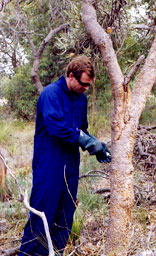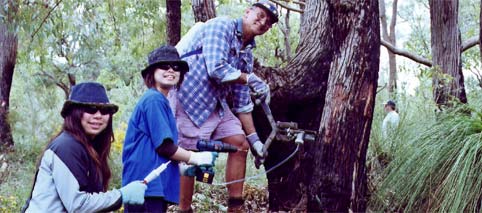Treating Your Plants with Phosphite
 Phosphite (phosphonate), is a biodegradable fungicide that protects plants against Phytophthora Dieback. Phosphite works by boosting the plant’s own natural defences and thereby allowing susceptible plants to survive within Phytophthora Dieback infested bushland.
Phosphite (phosphonate), is a biodegradable fungicide that protects plants against Phytophthora Dieback. Phosphite works by boosting the plant’s own natural defences and thereby allowing susceptible plants to survive within Phytophthora Dieback infested bushland.
It is important to note that there is no chemical that will eradicate Phytophthora Dieback, including phosphite. However, an integrated approach can successfully control the spread and impact of the disease. An integrated approach may combine strategic phosphite treatment, controlling access, correcting drainage problems and implementing excellent hygiene protocols.
Phosphite controls many species of Phytophthora, including Phytophthora cinnamomi. Phosphite is not toxic to people or animals and its toxicity has been compared to table salt. There is a very low pollution risk associated with phosphite. When phosphite is sprayed on to the foliage of plants, it is applied at a very low rate, so any phosphite that reaches the soil is bound to the soil and does not reach the water table.
Phosphite is available from most large nurseries and rural supply stores. Treating plants with phosphite is inexpensive – a medium sized jarrah tree requires less than 50 cents worth of chemical to treat.
Phosphite needs to enter a plant’s water transport system in order for it to be effective. This can be done by injecting phosphite into trees or spraying the leaves of understorey plants. In bushland, the most common tree species injected include jarrah, snotty gobbles, banksia species, sheoak and woody pears. Only inject trees with a diameter at chest height of 10-14 cm or greater. Phosphite not only protects a plant from Phytophthora Dieback infection, it can also help a plant to recover if it is already infected. If a jarrah tree is showing signs of infection, treatment with phosphite can help to save it.
Injecting a tree with phosphite provides three to five years protection from Phytophthora Dieback. In contrast, spraying with phosphite provides protection for only one to two years. Because it only provides temporary protection, treatment needs to be ongoing and included in bushland management and future action plans.
Injecting and spraying a large reserve can be a large task for a small community group, so consider applying for funding to employ a private contractor, Conservation Volunteers Australia, Greencorp or similar labour force to assist your group to complete the treatment.
Precautionary Note
This section outlines the best practice of managing Phytophthora Dieback as developed through research by the Department of Parks and Wildlife. For information about more research please contact the Science Division at DPaW.
In some cases stressed plants that are treated with phosphite will show signs of leaf burning. In most cases, this is a short-term effect and the plant will recover with the change of the seasons. In a small number of cases the plants that are already infected may be killed by the added stress of the phosphite treatment. To reduce the likelihood of any potential leaf burning, the phosphite rates described are chosen from the lower end of the prescribed range. For injecting the rate is five percent, and for spraying one-third of one percent. Prior to undertaking any phosphite treatment of bushland for commercial gain… A contractor must contact the Australian Pesticides and Veterinary Medicine Authority for further information.
1. Injecting Trees

Equipment
- Phosphite injection can be done with large syringes or with a number of different types of stem injection equipment, for example, the Sidewinder tree injector, Rawlins tree injector or the F1-11 trunk injector.
- Cordless electric drill and an appropriate drill bit (4 mm drill bit with syringes). Follow safety instructions associated with the use of the drill.
- Phosphite (sold in a 20, 40 or 60 per cent solution, commonly sold under the label Fos-ject® or Agri-Fos®).
- Personal protective equipment including safety glasses, gloves, well-covered shoes and protective clothes.
Timing
The best time to inject a tree is when water is moving within the tree. Water movement is usually greatest in spring and summer. Injecting in the morning is usually more successful than in the afternoon. For further information on storage, disposal of containers and first aid consult the material safety data sheet for your phosphate product.
Preparation
- If using 20 per cent phosphite, dilute one part phosphite with four parts of water.
- If using 40 percent phosphite, dilute one part phosphite with seven parts water.
- If using 60 per cent phosphite, dilute one part phosphite with 11 parts water.
- Use a good quality water source, preferably scheme water or rainwater.
Procedure
- Drill a hole into the tree. Injection needs to be in the sapwood, so do not drill any deeper than 2-3 cm. Usually, the wood colour will change from the brown bark to white at the correct depth. Drill the hole at waist height so that injecting will be comfortable for you. The hole should be drilled at a slight downward angle.
- Drill a hole every 20 cm around the tree trunk (approximately one handspan). Multi-stemmed trees need holes in all stems.
- Follow the instructions that come with the tree injector regarding its set up and use.
- Insert the nozzle of the syringe or injector into the drilled hole and twist slightly to get a good seal. Slowly push/pump the solution into the tree. Make sure the solution is taken up by the tree and does not run out. Inject 20 mL of the solution into each hole.
- Monitor plant health. If there is no sign of a decline in plant health, repeat in three to five years’ time. If plants show a decline in health prior to three years, repeat treatment.
2. Spraying Plants
The solution for spraying is much weaker than for injecting and contains a small amount of wetting agent or penetrant to hold the droplets on the leaf surface until they are absorbed. Not all understorey plants are at risk but it is easier to spray all plants. Phosphite spraying should not be conducted along creek lines and streams as it can cause adverse effects on some amphibious animals.
Equipment
- Backpack sprayer – ensure that it is clean and has not recently contained herbicides or other chemicals.
- Phosphite – sold in a 20, 40 or 60 per cent solution, commonly sold under the label Fos-ject or Agri-Fos.
- BS1000 (available from Mirco Bros 08 9410 2233) or another wetting agent or penetrant approved for use on native plants. Use rates recommended by the manufacturer.
Timing
Spraying is most effective in spring and summer. Spraying should not occur one day after rain or one day before rain.
Preparation
- Dilute phosphite to approximately 0.3 per cent phosphite for spraying.
- For a 20 per cent phosphite solution, this is one part phosphite to 40 parts water. Therefore, to make 10 litres of solution, add 150 mL phosphite to 10 litres of water.
- For a 40 per cent phosphite solution, this is one part phosphite to 80 parts water. Therefore, to make 10 litres of solution add 75 mL phosphite to 10 litres of water.
- For a 60 per cent phosphite solution, this is one part phosphite to 120 parts water. Therefore, to make 10 litres of solution, add 50 mL phosphite to 10 litres of water.
- Shake well.
- Be sure to add penetrant or wetting agent before use as per the manufacturer’s instructions.
- Use the solution immediately and mix frequently.
Procedure for backpack spray unit
- Place the backpack spray unit on your back and adjust the straps so it is comfortable and the pumping lever is on your preferred side. Adjust the nozzle so it gives a coarse spray to ensure the spray doesn’t blow away from the plants.
- Soak the plants so all leaf surfaces are wet to run off. All understorey plants, including grass trees, should be sprayed. 10 litres of the solution should last about 15-20 minutes.
- Monitor plant health. If there is no sign of a decline in health, repeat in one to two years’ time.
Larger spray units, for example, a spray trailer, can be used and may be more efficient when treating large areas. The chemical concentration should be the same as the concentrations listed above, and the chemicals should be kept well mixed.
Common Phosphite Products
Product Name: Anti-rot
Company: Yates
Suppliers: Selected hardware stores, nurseries and supermarkets
Rate of active ingredient: 20%
Size: 500 mL
Product Name: Phos-inject 200
Company: David Grays
Suppliers: Selected hardware stores, nurseries and supermarkets, plus David Grays Trade Centre
Rate of active ingredient: 20%
Size: 1 L
Product Name: Aus-phos
Company: Australian Agricultural Chemicals
Suppliers: Agricultural Supply Companies
Rate of active ingredient: 60%
Size: 20 L
Product Name: Agri-fos 600
Company: Agri-chem
Suppliers: Landmark Operations, Mirco Bros, The Farm Shop and Agricultural supply companies
Rate of active ingredient: 60%
Size: 1 L, 5 L, 20 L. Please note 20 L is the most widely available size
Product Name: Rutec
Company: Rutec Pty Ltd
Suppliers: Mirco Bros
Rate of active ingredient: 40%
Size: 20 L
Product Name: Rid a Rot (Sharp Shooter)
Company: Ausgro Technologies
Suppliers: Bunning’s
Rate of active ingredient: 20%
Size: 250 mL

